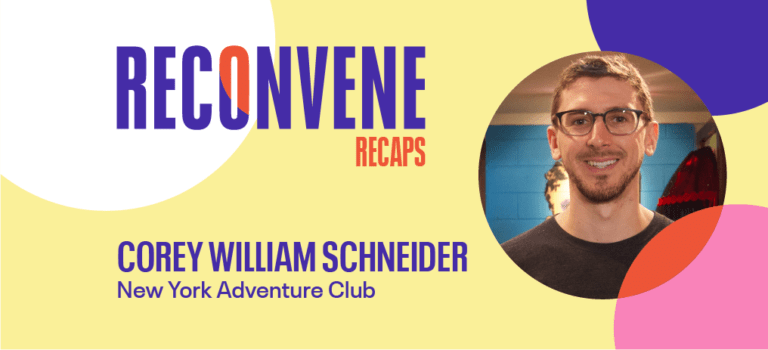Eventbrite hosted the RECONVENE summit in May 2021, bringing together thousands of event producers. We’re sharing key takeaways from popular sessions – on topics like safely returning to in-person events, a hybrid approach to events, and best practices for growing your audience – on our blog and our RECONVENE Recaps hub.
Corey William Schneider started the New York Adventure Club because he was looking for some, well, adventure. On weekends, he went to the city’s restaurants, bars, and brunches, but he didn’t really know anything about the city, even though he had lived there for a year. So he made a self-pact to go out every weekend and try something new.
That pledge has evolved into the New York Adventure Club, which, prior to the pandemic, hosted around 20 events a week for a community of more than 1,500 people. The events, which are geared toward a local audience, curate special, behind-the-scenes access in and around New York.
When the pandemic hit, Schneider realised he could adapt engaging in-person content for a virtual medium. Virtual events helped his group earn more monthly revenue than ever before, and they’re also “extremely accessible,” he pointed out.
During Eventbrite’s RECONVENE summit, Schneider discussed how the New York Adventure Club will continue to innovate its virtual offerings while resuming in-person events. Here are four takeaways on this hybrid approach for creators.
Watch Corey William Schneider’s full talk here:
Find the virtual platform that fits your hybrid approach
We’ve all become super familiar with Zoom. But it’s not necessarily the right platform for all events. The key is choosing “the right one for you and your company,” Schneider says. “There are tons of options out there now: You’re bound to find one that has the core features you’re looking for.”
When Schneider was evaluating different options, he thought Zoom was overly complex. He wanted a simpler viewing experience, and he worried about people sharing the password after buying tickets on Eventbrite – or events being Zoom-bombed. It was important to him that a platform offered ticket purchase integrity, and that events would run as smoothly as a TV production. He ultimately settled on Livestorm, and has used it throughout the entire pandemic.
[cta id=”228563″]
Think creatively to adapt in-person events to a virtual format
Almost every in-person event can be adapted successfully into a virtual offering, Schneider says. For example, a neighbourhood walking tour can transform into a webinar with historic photos and videos. Hosting a tea ceremony? Have the instructors teach it from home. Want to do a whiskey tasting? Mail tasting kits to attendees ahead of time.
Schneider also recommends considering how you can add a virtual component to existing in-person events. Not everyone who’s interested in a standalone virtual event will be able to attend. So why not try to bring a taste of the experience to them?
With a hybrid approach, virtual events are a complement to in-person events
Virtual events aren’t competition to in-person events, and they’re not a substitute for them either, Schneider says. Both types target a completely different audience. By hosting virtual and in-person events, you’ll encourage crossover between the two.
In-person and virtual events can even happen simultaneously. For example, the New York Adventure Club is now hosting webinars about Roosevelt Island and City Island, while also resuming in-person tours of both spots. The in-person events have been selling out, and demand has remained consistent for the webinars. “It proves the point that there are two audiences for two different mediums,” Schneider says.
Some events will stay virtual in a hybrid approach
The New York Adventure Club’s in-person lecture series will probably bite the dust, Schneider predicts. Virtual lectures trump in-person versions in almost every way: They can accommodate a larger number of people, there are instant reply capabilities, they’re easier to manage, and they don’t require an expensive venue or AV equipment. Plus, they won’t be ruined by someone forgetting to turn off their phone ringer.
Take inventory of all the types of events you host, and figure out which need to be in person to thrive, and which make more sense to hold virtually.





